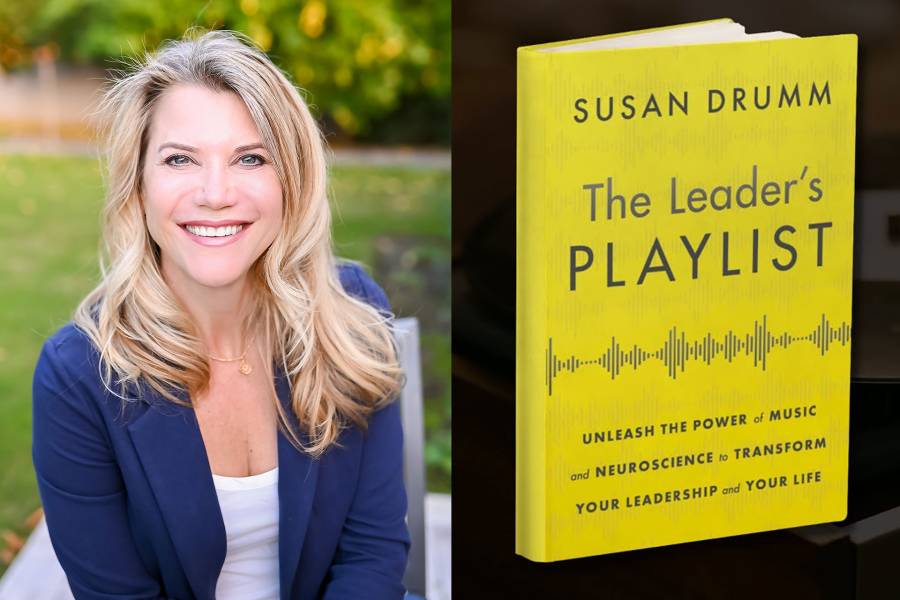For leaders, there are few moments of real quiet. There’s always a knock at the door, a text, a call waiting, an upcoming meeting, a decision pending. These interruptions impede effective leadership skills. They are a deflector to drown out. In a word, noise.
Behind it all, there’s a constant, subconscious playlist on repeat. It whispers a persistent story, over and over again—either encouraging or stunting the leader’s capabilities and ability to lead productive employees.
That playlist might say:
- You don’t belong here.
- You aren’t appreciated.
- You aren’t successful enough.
Author Susan Drumm, CEO advisor and leadership coach, identifies these playlists alongside literal music as powerful leadership skills. Leaders can harness them to expand their potential and improve their skills. In her book The Leader’s Playlist: Unleash the Power of Music and Neuroscience to Transform Your Leadership and Your Life, Drumm draws on years of neuroscience research and 20-plus years of experience coaching leaders to teach readers how to unlock the doors to better leadership.
A New Approach to Leadership…and Change
If you’ve ever tried, and failed, to change how you do something—whether it’s dropping an old habit or shifting your mindset—there might be more than just willpower at work. Drumm states that our childhood experiences kickstart a “playlist” that affects our efforts and growth until we consciously change it.
Consider a leader who constantly checks their email. Efficient leaders often turn notifications off. Instead, they opt to batch their communications rather than get distracted every few minutes by a new message. Knowing that this is an option, why would a leader remain addicted to their notifications?
Inner Playlists: Their Origin and Effect
To figure out why, according to Drumm’s methods, they would need to first identify what playlist they’re listening to. For example, perhaps as a child, they were expected to answer right away whenever an adult spoke to them—no matter what they were doing or who the adult was. Today, they might have lingering anxiety when they don’t respond to messages right away. Their subconscious playlist might be saying, If you don’t respond immediately, you’re failing at your responsibilities, or you will miss something super critical.
- In short: “I need to be perfect.”
Once that playlist is named and categorized, it can be changed through building new neuro-pathways. What does the leader want to feel, instead of the pressure cooking of being “on” all the time? It might be that time away from work and reflection time is beneficial to results, and they give themselves the grace to experience that. And with this change the new behavior becomes: You set reasonable expectations with your employees about how quickly you will respond, so it’s appropriate to only reply to messages during predetermined blocks of time.
- In short: “I successfully manage expectations.”
Then, Drumm goes a step further, tapping into the power of music to rewire old brain pathways. She teaches how to build a playlist of songs, old and new, that can give our brains shortcuts to learning these new patterns of thinking.
Drumm includes a 7-step process in her book—the same one she uses with her executive clients at her consulting firm, Meritage Leadership Development—to walk readers through the process for themselves.
Applying Drumm’s System to Four Leadership Scenarios
During the 2022 Christmas travel season, Southwest Airlines canceled over 15,000 flights, a fiasco caused first by bad weather and then by a decrepit IT system.
Forbes shared an article by author Jon Picoult about four leadership lessons we can learn from the Southwest scenario, regarding handling failure, triaging priorities, listening to employees, and the importance of brand equity. Here’s how a leader can apply Drumm’s playlist concept to the three most relevant of those scenarios.
1. Demonstrating Confident Leadership in the Face of Failure
First, how does a leader handle failure? Can they dust themselves off and make things right? Do they give up and go down in flames? Their internal playlist might feed them a definition of success that impacts their response to failure. Suppose their internal playlist reflects a fixed mindset, where they believe they already have all the talent and leadership skills that they’re ever going to have. If so, that might make them more prone to giving up after a failure or denying that one even exists.
Leaders can determine how they want to lead through failure and use Drumm’s neuroscience research to rewire their brains for maximum effectiveness in this area. They might develop a playlist full of songs with emotional vibrations that exemplify victory, getting back up when you’re knocked down, and redemption. Listening to that playlist would help their brain solidify the truth that even though they failed once, they can try again—they’re not doomed to failure.
2. Determining a Company’s Order of Priorities
Second, how does a leader triage what’s most important—how do they decide where their resources and energy go? Their internal playlist has opinions about what’s important.
Maybe they have always expected to look successful regardless of reality. That being the case, they tend to invest their resources into “looking good” with smoke and mirrors: If I acknowledge that I’ve made an error in judgment or failed to plan for this contingency, it will undermine all of my authority.
- In short, “All eyes are on me and almost certainly judging me unfit.”
If so, their playlist motivates them to trot out their qualifications. This response is a defense mechanism. It justifies self rather than addressing the issue at hand.
In that case, they would need to rewrite that unhelpful playlist to prioritize the talents and leadership skills available through others. They would need to redirect their attention off self and onto the qualifications of others. They might then build a playlist that encourages pulling together in tough situations. Their playlist motivates them to mutually encourage one another and persevere through trials.
3. Accepting Feedback…Regardless of the Source
Third, from where does a leader get feedback? Do they ask their own frontline workers for input, do they rely solely on customer data, or do they use a well-filtered mix?
When a leader feels unable to listen (really listen) to their own people, there could be several negative internal playlists at work, too. The playlist could be telling them that no one outside their inner circle is trustworthy. The playlist could tell them that only fellow executives are worthy of respect. Ideas like these can harm their relationships and growth without ever being said out loud. For some, these ideas could even be a source of shame.
By realizing that the source of negative ideas is not necessarily moral bankruptcy but rather an old playlist stuck on a loop, the leader can break out of old habits and look at feedback with fresh eyes and fresh tunes in their earbuds.
Using Playlists to Improve Leadership
Drumm holds a JD from Harvard Law School and Master Certified Coach status. Additionally, Drumm holds a graduate drama degree from the London Academy of Music and Dramatic Art. She understands the power that both science and art have, coupled together, to propel individuals and teams forward.
Drumm leverages the diversity of her own background to function as a playlist for her work. Her system draws strength from the fact that entrepreneurs can apply it in a myriad of leadership situations. It’s especially potent when leaders are willing to do some deep reflection and work on their own thought patterns. Years of neuroscience research, explained by Drumm, provide a powerful backdrop for how people can change and improve in areas they previously felt stuck.
Best of all, this work involves one of humanity’s favorite art forms (and one that can improve employee morale, too): music. In short, Drumm teaches how to use literal playlists to improve your leadership skills. Consequently, this skill then helps leaders see noticeable results and improvements for teams of all kinds. So yes, those few moments of quiet may actually get filled with some transformational new songs. But according to the research, that time spent with carefully curated playlists will be well worth it.


















